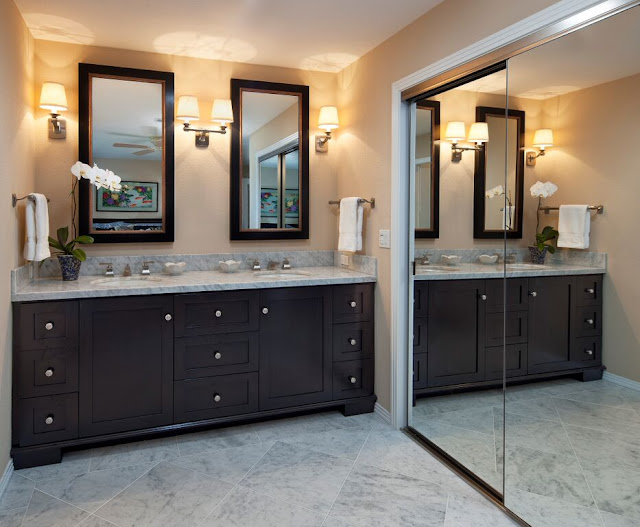As human beings, we need light to see shapes and objects that surround our lives. Without it, we would be stumbling over the cat or bumping into the nightstand in the middle of the night when we are headed to the fridge for a midnight snack. We need light in our homes or work spaces to be able to function, and where we place our overhead light fixtures or wall sconces should be thought through thoroughly. Lighting is a quick and easy project that can have a major impact on the functionality as well as the design of your home.
When discussing lighting options, there are 3 types that are used by designers: ambient, task, and accent.
- Ambient is considered the general or overall lighting in the room.
- Task lighting is for work areas that need more illumination.
- Accent lights are focused more around design, rather than function.
Here are some recommendations for lighting throughout your home.
The Bath
Most grooming and makeup application takes place in front of a bathroom mirror, so lighting this space needs to be done well. Installing a task light above the mirror may be the knee-jerk reaction, however, they typically cast shadows under the eyes or chin.
Wall sconces are a great remedy to the dreaded shadows. If they are placed correctly on the wall, 75-80 inches above the floor and having at least 24 inches between them, the light will be evenly distributed over the hair and face of an individual. If your space does not allow for this composition, a task light that is situated above an oversized mirror with lamp globes that send light down rather than up, will alleviate the shadow issue.
The Kitchen
The kitchen is another critical space to have first-rate lighting. Chopping and sauteing are occupational hazards, after all. Because the kitchen is the heart of the house, combining, ambient, task, and accent lighting results in a comfortable atmosphere.
Using recessed lighting in the kitchen will enable you to have a lot of focused light on work surfaces like the sink, stovetop, and your prep stations. They can be placed in the ceiling and also under the cabinets to get extra focus on the countertops. Speaking of, in-cabinet lighting can be twice as functional. Adding lights inside of glass-doored covered cabinets brings a warm illumination to the room, as well as the functionality of being able to see the items inside. Pendant lighting is another great way to get focused light, while adding a design element to your kitchen.
The Living Room
The living room is often the first room people walk into, which means it’s setting the tone for the rest of your home. This first impression should be met with inviting light.
Use accent lights to highlight parts of the room that mean the most to you: a fireplace, a painting, or a special architectural detail of the space. Recessed lights are a good option for accent lighting since it can focus directly onto objects.
Ambient lighting is another way to create a welcoming atmosphere. It’ll also likely be the first light you switch on when you enter the room. Wall sconces, pendant lights, and chandeliers are just a few ambient lighting options.
The Bedroom
Symmetry and balance is the application used most in bedrooms, particularly around the bed. Matching wall sconces that adorn either side of the bed, create both ambient and task lighting.
Lights on the ceiling are also a popular ambient lighting option in the bedroom. Whether you are choosing recessed or a flush-mounted fixture, they create plenty of light to be helpful. Fixtures that include a ceiling fan for climate control, become a double functioning piece and are a welcome feature to homeowners.
Light Bulbs and Dimmers
Depending on the style of your home or personal preference, you’ll need to decide on the light temperature, which is measured on the Kelvin scale. The older incandescent light bulbs gave off a warm, rich light at 2,900-3,200k, whereas the newer compact fluorescent bulbs give off a cool, clean light at 4,000k. If you aren’t sure where you fall, there is also neutral white, which falls at 3,500k.
When considering your lights in any of your rooms, think about adding a dimmer switch to them. Depending on the time of day, the amount of light coming from ambient or accent light sources, can completely change the atmosphere in the room.










No comments:
Post a Comment